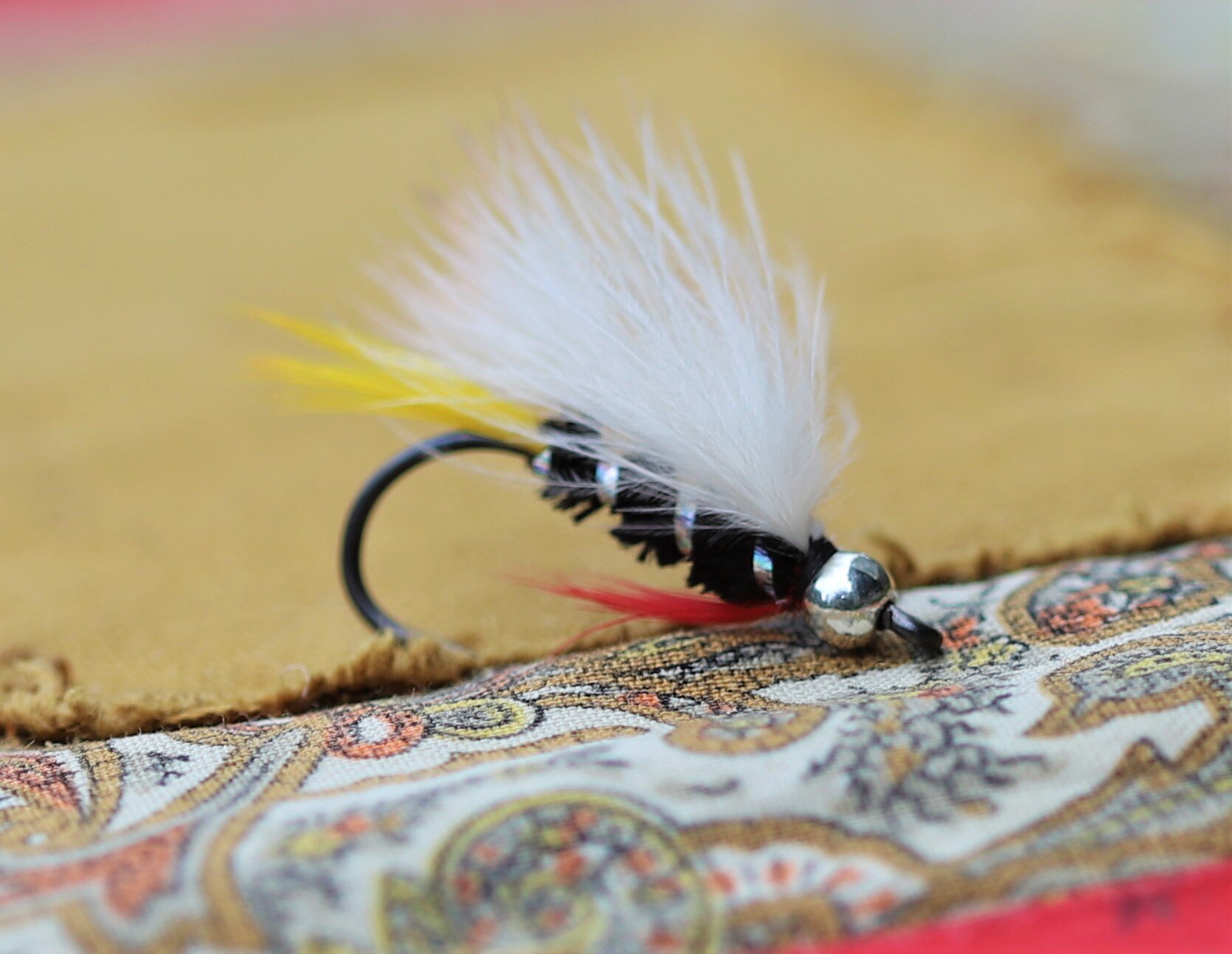
Streamers: Chase the BIG Fish!
There are few patterns more effective than streamers when attempting to catch large fish on a regular basis. Lots go into their design, from materials with movement to colors that trigger a reaction. Add to this specialized fly fishing techniques and you can see that there is a bit of a learning curve. Let me lessen that with the flies!
A streamer I first fell in love with is the Black Ghost, this version tied with a white marabou wing. The added tungsten bead adds weight plus instills a bit of a jigging motion during the retrieve. Overall, a simple pattern, yet one that has been effective for many years.
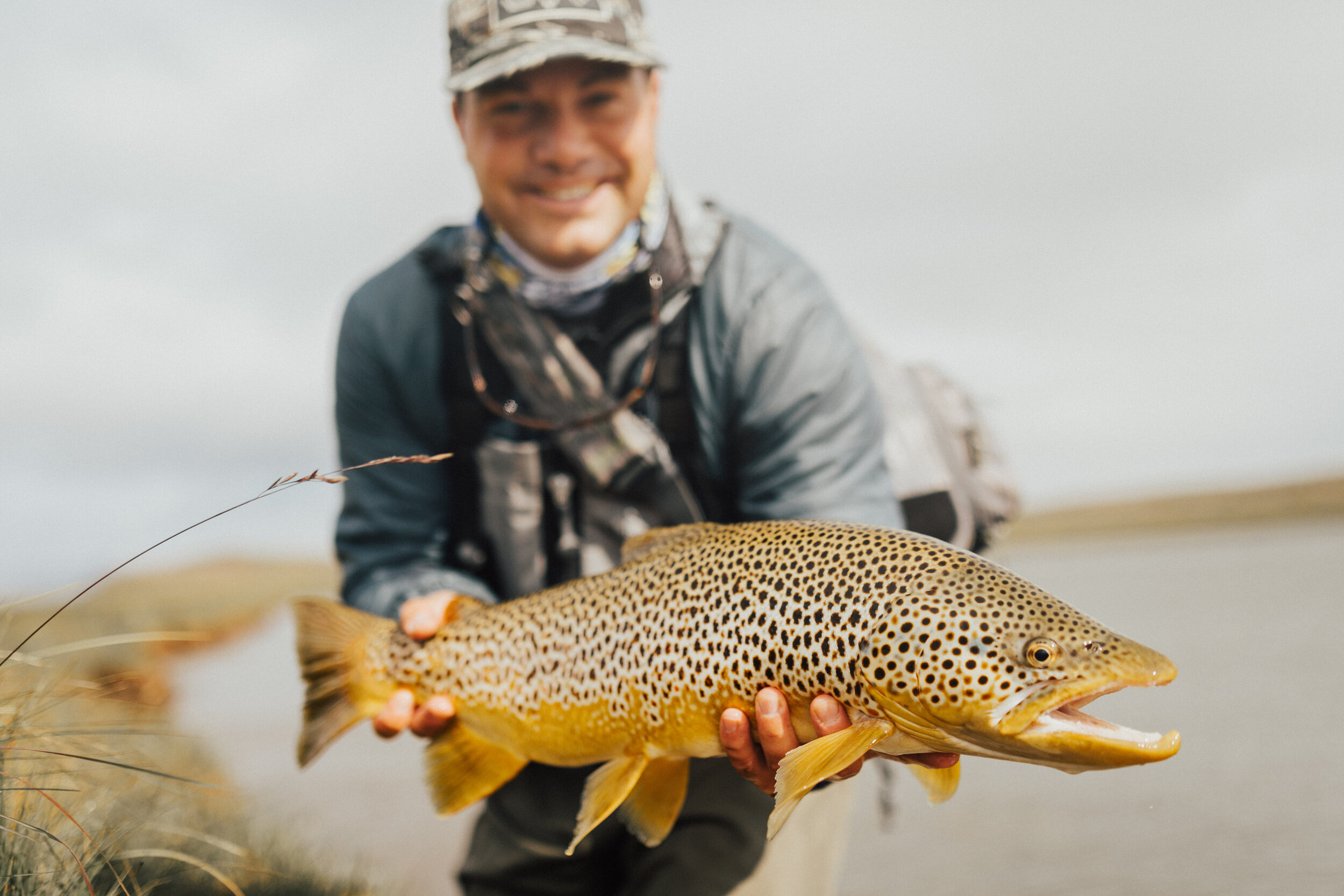
Caught on E.P.’s Articulated Streamer, this gorgeous Icelandic brown trout is considered a small one there, REALLY! That is the reason I return there yearly, and contact me if interested in coming along. There is something special about catching Ice Age brown trout…on an 8 weight!
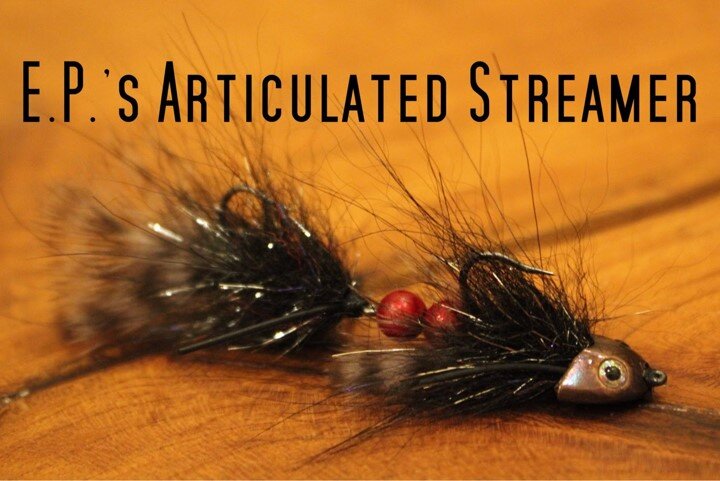
Articulated Streamers
A step-up from standard streamers, articulated patterns have either multiple hooks (when legal) or a hook and a shank to build LOTS of movement into the pattern. Select materials that provide an illusion of bulk and shed water when casting; your arm will thank me later!
The fly that fueled this addiction for me is the EP Articulated Streamer, a gateway pattern into this niche of streamers. Concentrate on building a strong connection to tie the two hooks together because there is nothing worse than losing the fish of a lifetime (in ICELAND!) because you didn’t test it before making a cast. Tie this fly in a variety of colors and varying head selections so you’ll be able to imitate baitfish everywhere you go…and the larger fish will respond.
Throughout the fly tying tutorials, variations are listed, and I encourage you to modify the patterns to more accurately reflect the baitfish in your local waters. In Pennsylvania, I tend to opt for small sizes (1” - 4”), but that also varies on the water type and time of year. Enjoy!

One of Lefty Kreh's most effective flies, this Woolly Bugger is tied with peacock herl for the body instead of chenille. That slight variation makes for an incredible pattern, and one that belongs in everyone's fly box. Fish this pattern with confidence...

This classic streamer is a go-to fly for many because of its ability to accurately imitate baitfish. The Black Ghost has been an effective fly for me over the years, especially on stocked trout. There are a few variations, as noted in the video, but I always attempt to maintain the integrity of this fly to ensure future success. PS - This is one of my Great Uncle John's favorite flies!

In this fly tying tutorial, Chuck Furimsky is our guest tyer and shares his Turbo Tail pattern. This unique tie features Chuck's Bugskin material, and there is no doubt that his creativity shows with this one. Chuck does an excellent job tying, plus shares a lot of great stories and thoughts along the way. Additionally featured in this video is some incredible underwater camera footage by Tim Flagler of Tightline Productions.

The Sculpzilla was created by the Solitude Fly Company to represent sculpins, and this patterns has been earning the respect of many as of late. The fly works very well in a variety of conditions, plus it's easy to vary to mimic sculpins, leeches, and other bait fish in your area. If you know of sculpins in your local waters, I recommend having the Sculpzilla in your box!

The Crystal Bugger is a FAST fly to tie, and effective on multiple species of fish. The crystal chenille used gives the fly many strands of flash, allowing me to leave out the typically-required hackle. Adding weight to this pattern is something I believe improves its effectiveness, and a variation that I consistently make is the addition of dumbbell eyes.

It's not too late to learn about and try articulated streamers! In this video, I share my "base" pattern, which you can modify with many options. Keeping it simple is the key to me, and most importantly, be sure to check your connections before fishing!

This Sculpin Bugger is a fun pattern to tie and very effective due to its ability to quickly get into the lower third of the water column. Tied with a Sculpin Helmet from the Flymen Fishing Company, this pattern combines weight with flash, plus the other excellent characteristics of a Woolly Bugger.

Tied with the Fish Skull Baitfish Head, this Black Bunny Leech is suggestive of many food items for fish, including leeches and baitfish. In my boxes, I carry this pattern in a variety of colors, and encourage you to do the same.

Created by John Rohmer, this has become a "go-to" pattern for many fishing stillwater due to its ease of tying and great ability to mimic leeches. The Simi Seal Leech has excellent movement in the water, and will continue to produce in various lakes and ponds everywhere.

Featured in this "Two Minute Fly Tying" tutorial is the Krazy Carper from Jamie Kaminski. Though catching the attention of those fly fishing for carp, this pattern is quickly developing into one that's known to be effective with many species. The Krazy Carper is a simple one to tie, and allows for many color combinations and variations with its body material. This is a great fly to fish, with one of the Krazy Carper's most important features being its similarity to the Zonker-style of flies.

Crayfish are an excellent food to imitate, and this one uses "Furry Foam," an easy to obtain material that looks great when wet. Large fish, such as smallmouth bass and brown trout, key on crayfish, especially during the summer. This is a great pattern to try, and I discuss some other colors in the video that I've had success with. Additionally, if you want to reinforce the foam, tie in some copper wire to rib everything with, though this is something I rarely do. Overall, this is an effective pattern that meets that "GISS" qualifier, thus be sure to have confidence fishing this "Furry Foam Crayfish."

There are many leech patterns out there, yet this one may be the fastest I've ever tied; thanks to Landon Mayer for creating this simple yet effective pattern! This pattern is a variation of his original, being that I have modified it slightly for carp...but don't forget that Landon recommends tying this in smaller sizes for trout. More is discussed about the pattern following the tying, and I'd love to hear your thoughts on it as well. This is part of my "Two Minute Tying" series, and it's a great fly that can be tied quickly and easily at the vise.

When it comes to successful patterns, sometimes less is more, and it sure seems that way on the MS Bugger. This is a pattern with few materials, yet has an incredible look both at the vise and in the water. One the water, there are many ways to fish the MS Bugger, and the trout seem to like them all!

Guest tyer John Mlakar ties a great pattern known as the Swimming Crane Fly Larva and then shares some of his personal variations (which I highly recommend looking into!). John also gives us some tips to fish this fly, which is a simple and effective one. Have fun with the variations of your own, and let us know how you like this Swimming Crane Fly Larva.

Here's a variation of my favorite Landon Mayer pattern, the Mini Jig Leech. With the addition of a jig hook and some Solarez Bone Dry, this pattern is now ready to go! Join me in the video as I tie the Mayer's Mini Jig Leech, interview Rob Giannino from the Fly Fishing Journeys podcast, and discuss fishing Wyoming's North Platte River with Ryan Anderson of Wyoming Fly Fishing. Lots in this one!

The Extreme Stickleback is a bait fish imitation that you can tailor to represent those in your local waters. After the tying, stick around to learn more about how we used it in Iceland to catch their incredible brown trout. Lots of guests, information, and fun in this one!

Substituting schlappen for the traditional saddle hackle used on a woolly bugger, you can see the truly buggy look that is gained with its addition. This schlappen, from Clearwater Hackle, is a great material that I turn to more often than not when tying, plus its movement in the water really helps this Schlappen Woolly Bugger into an even more effective pattern.

Bob Clouser's famous fly needs no introduction. This is a pattern that has caught an incredible amount of species in so many water types, as eveidenced by the amount of time Lefty Kreh discusses it in his writings and presentations. Feel free to vary the color and weight, though no matter what, have some of these in your boxes at all time! The Clouser Deep Minnow is a fly that always produces...

Joe Kayafas shared this Intruder pattern with us on my YouTube page, and though I can't say it's entirely a streamer, I know many would place it into that category. Joe does a great job explaining all of the stages of this fly's creation, and there are many tips and techniques given throughout the tutorial. This is an excellent steelhead pattern, especially for those who enjoy swinging flies.

This popular streamer is part Zonker and part Muddler, taking valuable characteristics of both flies and putting them together in one pattern. The Zuddler Conehead Minnow has great movement in the water, plus its color can be varied to match baitfish in your local waters.

With so many Woolly Bugger variations out there, I figured that there might as well be one for the Pittsburgh Steelers! This fly was created during football season one year as part of a thread on the Fly Tying Forum, and as you can probably guess, I've received many reports from people saying that this pattern has done really well on a variety of fish. Sometimes it is best to let your creativity guide you when tying, which is what I did when working on this "Steeler Bugger."

My friend Tony Spezio shared his Woolly Bugger modification with me, and upon tying it for YouTube, I received lots of emails from fly fishermen reporting its success. The Chili Pepper fly has a copper chenille body, which definitely drives some fish crazy. Be sure to have these in your streamer box when on both streams and stillwater.

Nearly every beginner when learning to tie today is typically started with the Woolly Bugger, and with good reason: They catch fish! In this tutorial, I go over the basic procedure, but also offer a few variations to make your fly different from the others being fished today.

In this video, Stephen "Big T" Tomasovich is the guest tier, sharing an exceptional Euro nymph, the CDC Micro Bugger. Simple to tie, plus MANY ways to fish this streamer...it belongs in your box! Tie this in a variety of your favorite colors, including peach, olive, and black. Afraid to use CDC on a streamer? Get over that fear, as the fish certainly appreciate it. ;-) Thanks again, Stephen, for sharing this one!

In this fly tying tutorial, I demonstrate the tying methods for a fly called the CrawBody Crayfish. Representing a favorite meal of both trout and smallmouth bass, the crayfish as a pattern is intended to be fished lower in the water column, and can be utilized in both streams and lakes. There are many variations that you can make to this intermediate pattern, thus feel free to experiment and determine what works best on your local waters.

With Halloween around the corner (@ the filming of this video), it was suggested by my wife that a Halloween pattern would be fun...and I agree! This fly is part Slumpbuster, part Meat Whistle, part Zonker, and the rest is just fun. The best part is that the fly catches fish! At the end of this video for a fly I decided to call "Medusa's" Halloween Streamer, there is even a little glow-in-the-dark; what more can you ask for around this holiday?
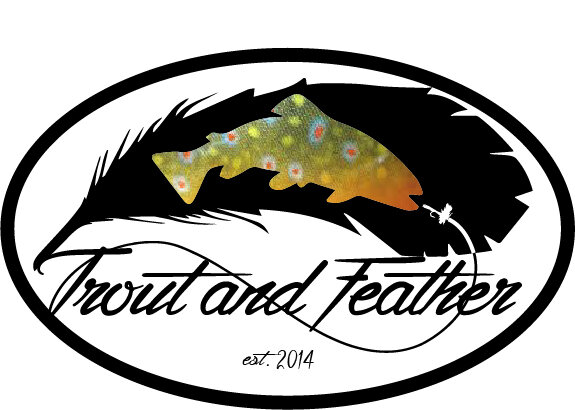
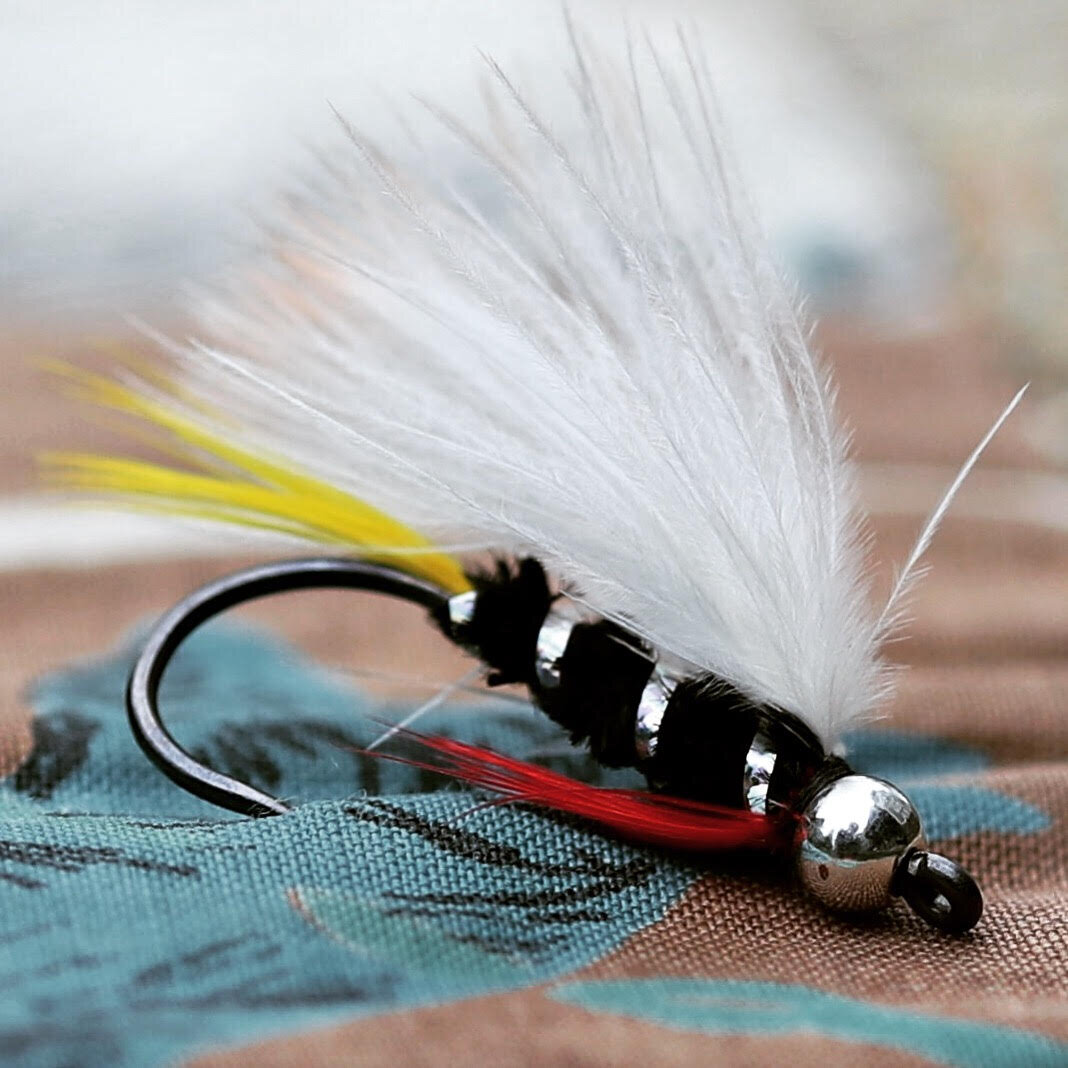
Created by John Barr, the Meat Whistle is a fly that has lots of movement in the water. The pattern does a great job of imitating many types of bait in the water, including minnows and leeches. This video features a jig nymph hook, which allows the fly to ride hook point up. Have fun fishing this pattern for trout, stripers, steelhead, and many more!